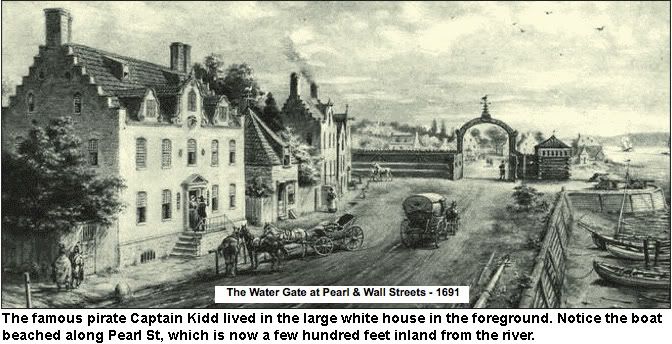
from racontours
No greater collection of characters ever settled together than in the early days of the Manhattan Colony. Lying on the outskirts of the British Empire, New York became something of an open port and attracted a certain kind of individual. Unlike Boston or Philadelphia, New York had no predominant religious influence - no Puritans, no Quakers or Lutherans determined to reform public morals. And though it was taken over by the English in 1664, it had not lost its Dutch mercantile roots. Cash was king, as it remains today, and scruples were few.
The slave market operated at the end of Wall Street, where the cannons are in the picture below. The famous pirate Captain Kidd lived in the large white house in the foreground. Notice the boat beached along Pearl St, which is now a few hundred feet inland from the river. At the end of Pearl Street is the wall for which Wall Street is named.
A biography
William Kidd was born in Scotland and found his way to New York in search of opportunity. When England and France went to war in 1688, Kidd became a privateer - a pirate with a license from the King of England to plunder French shipping. Kidd had a talent for privateering and made a fortune doing it. He married a New Yorker and settled down in this big, white house (above), and joined the ranks of society.
Kidd's investors included some of the wealthiest, most respectable men in New York, including the Colonial Governor Lord Bellomont, and Kidd himself was one of the original donors for the construction of Trinity Church. Kidd would be hanged for piracy in 1701, on trumped up charges that were considered unfair even by the standards of the day. He had captured a ship sailing under French colors in the Indian Ocean, and then concealed part of the treasure from his partners. They later user their connections to ensure his doom.
But pirates continued to thrive in New York: "It is certain that these villains" wrote an East India Company official, "frequently say that they carry their unjust gains to New York, where they are permitted egress and regress without control, spending such coin there in the usual lavish manner of such persons!"
The pirates boosted the sagging local economy. New York merchants such as Steven De Lancey - of Delancey Street - financed ships that sailed halfway around the world to sell provisions and arms to New York pirates operating out of St. Mary's Island, Madagascar. And shares in these voyages - some promising a twenty-fold return on investment - were openly traded in taverns along Wall Street, one of which (the Tontine Coffee House) became the home of the New York Stock Exchange.


























No comments:
Post a Comment